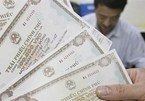 |
| Government bonds issued by the Ministry of Finance. Between June 1 and August 15, Vietnam’s bond yields fell thanks largely to positive sentiments over Vietnam’s economy |
The report, released on September 18, said that bond yields declined an average of 44 basis points across the curve, with the one- and seven-year bonds shedding the least at 37 basis points each. As a result, the spread between the two-year and 10-year tenors widened to 136 basis points from 129 basis points.
“Vietnam and the Philippines were the only markets in emerging East Asia that saw a widening of the spread between two-year and 10-year yields during the review period,” noted the report.
The downward trend in bond yields was largely driven by positive sentiments over Vietnam’s economy as the ongoing trade dispute between China and the United States turned into gains for the domestic economy.
As China and the United States imposed tariffs on each other’s goods, importers from both markets have turned to Vietnam’s manufacturing-driven economy for trade, according to the report.
“While the United States is also considering imposing tariffs on Vietnamese goods, trade pacts and concession agreements that Vietnam has entered into with other markets can serve as a buffer against U.S. tariffs,” it pointed out.
The report added that strong foreign inflows into the market also resulted in abundant liquidity, which led interbank rates to fall, resulting in yields trending lower across the length of the curve.
The Vietnamese central bank is reportedly opting to manage uncertainties in financial markets through macroprudential measures, including keeping the credit growth target at 14% for this year.
During the review period, the Vietnamese dong was one of two currencies in emerging East Asia that strengthened against the U.S. dollar, gaining 0.9%. Foreign direct investment and inflows into the equity market helped sustain the value of the dong, as well as intervention by the central bank.
Lowest LCY bond market
Vietnam continued to have the smallest LCY bond market in emerging East Asia, with outstanding bonds of VND1,233.5 trillion (US$52.9 billion) at the end of June.
Overall bond market growth rebounded in the second quarter of this year, rising 2.6% quarter-on-quarter from 0.8% quarter-on-quarter in the first quarter.
In late June, the outstanding stock of LCY government bonds climbed to VND1,127.6 trillion, rising 3.2% quarter-on-quarter in the second quarter of 2019.
The overall stock of government bonds was lifted by the surge in central bank bills in the second quarter of 2019, while Treasury bonds posted a slower expansion and government guaranteed and municipal bonds contracted during the review period.
Treasury bonds continued to account for most of the government bond stock, representing an 82.7% share of the government bond total. The stock of Treasury bonds totaled VND932 trillion in late June, up 1.4% quarter-on-quarter.
The outstanding amount of central bank bills jumped to VND33 trillion, rising more than six-fold on a quarter-on-quarter basis.
The State Bank of Vietnam resumed issuing bills in March, following a five-month hiatus, to siphon excess money from the banking system and safeguard the stability of the Vietnamese dong.SGT
Thanh Thom

Vietnam’s bond market continues growth
Vietnam’s local currency bond market grew 2.6 percent to 52.9 billion USD in the second quarter of this year, after a 0.7 percent expansion in the first quarter.

VN banks told to be careful with corporate bonds
Commercial banks’ purchase of real estate corporate bonds is considered indirect lending to real estate firms, experts say.
 Local currency (LCY) government bond yields in Vietnam trended lower between June 1 and August 15, leading the entire yield curve to shift downward, according to the latest issue of the ADB’s Asia Bond Monitor.
Local currency (LCY) government bond yields in Vietnam trended lower between June 1 and August 15, leading the entire yield curve to shift downward, according to the latest issue of the ADB’s Asia Bond Monitor.